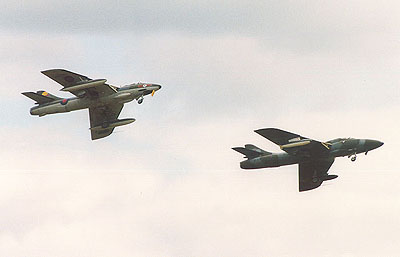 Cosy
Cosford Cosy
Cosford
RAF COSFORD AIRSHOW
- 10 June
Andrew Bates squeezes in.
Sales of ice cream and chilled drinks were likely to have
been substantially reduced at this year's airshow at RAF Cosford, thanks to the stiff
north-easterly breeze which ensured that temperatures remained at least 10ºC lower than
last year. However, despite a couple of hours cloud cover during late morning/early
afternoon, some of which looked decidedly grey, the threatened forecast of showers never
materialised, and there was sufficient sunshine to enable your scribe to return home with
more than a hint of a tan.
A ‘Different’ View by Andy Evans

For more years than I care to remember I
have taken my wife and four kids to the annual RAF Cosford Air Show. Since they were
babies the offspring have looked forward to the event, and even though they are now
teenagers they all still enjoy the spectacle. Although I only live four miles ‘down
the road’ it has always been something of a pilgrimage for me, and a chance to see
some ‘metal’ around the local area! Having queued with the best, we always left
before the end of the show to avoid the crush, and raced home to watch the Red Arrows
formate over our house. I anticipated this year to be no different. However, my first two
daughters and their boyfriends are involved with our local cricket club, and their pitch
is about a half-mile from Cosford, higher up and overlooking the runway. This year the
club had a barbeque on the air day, and insisted friends and family joined them.
So, although sad at missing out on the
atmosphere, we spent a leisurely afternoon watching the unfolding aerial displays from a
marvellous vantage point. Okay, although we did not have the pleasure of the museum, the
static park (although missing the latest Merlin HC3 was a bit of a minus), and the
aircraft parked on the runway perimeter, I did however take time to weigh up the
‘other side’. No hordes of people, no losing the car, no fighting for a place on
the crowd-line, no fun-fair, no blaring PA, not having to walk miles and queue up for a
smelly Portaloo, no ‘Sunday Market’ to encourage parting with cash, just
aircraft, ale, food, and family! For someone used to the airshow ‘circuit’ this
all made a pleasant change. However, the best was to come. As the display aircraft are
unable to pass over the crowd-line or circle above them to reposition due to strict
airshow regulations, they instead flew at low level right above our heads to make their
turns and runs thus creating an unrivalled position!
The content of the show was varied, with
the ‘usual suspects’ from the RAF, these being the BBMF, Hawk, Harrier, Tornado
F.3, Falcons, Hercules, Jaguar, Tucano, Nimrod and the ‘Reds’. Foreign delights
came in the shape of a superb show from a Belgian AF F-16, and a truly spectacular Mirage
2000B from Orange. The Royal Navy brought along a Lynx pair and an example of its latest
Merlin helicopter, which showed its agility, and quiet running for such a large airframe.
For its presentation the Army showed off the Blue Eagles. However the highlight for me was
a wonderful showing from ‘Foxy Lady’ the restored Sea Vixen. This was a
particular pleasure, as I had often seen her splendour flying from Llanbedr, and then
sadly witnessed her languishing outside the DERA hanger after her retirement.
Vintage and Veteran aircraft also
abounded, graceful Hunters, Bearcat, Wildcat, Spad & Corsair, aerobatics from Extras
and a nostalgic Dakota and Swordfish. There were a few ‘gaps’ in the flying
display but on such a fine afternoon who cared? Just allowed more time for another roast
pork baguette, a cold drink of Mr Carling’s finest and a game of footie with the
gang. |
True to form, the static display comprised of a small
selection of visiting aircraft, along with a number of instructional airframes from the
resident fleet of No.1 School of Technical Training (SoTT). As always, there was the added
bonus of seeing some of the exhibits from the RAF Museum being given a welcome airing
outside their normal display environment.
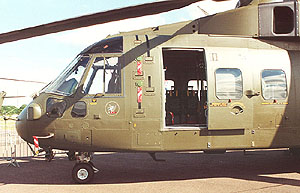 The main static park was
effectively dominated by the first time appearance at Cosford of an RAF Merlin HC3,
ZJ125/J from 28 Squadron at Benson. Unfortunately, of all the static aircraft present, it
had to be the Merlin that was blighted by poor barrier positioning, which ensured many
mutterings of discontent from all the photographers taking advantage of the early morning
sunshine. However, a pair of static participants, parked just a short distance from the
Merlin, swiftly tempered this discontent. Making an all-too rare appearance in the UK, was
a pair of Irish Air Corps SF260WE Warriors; 227 & 230. This
participation from Eire marked another first for Cosford, and proved to be a popular draw
for enthusiasts. The main static park was
effectively dominated by the first time appearance at Cosford of an RAF Merlin HC3,
ZJ125/J from 28 Squadron at Benson. Unfortunately, of all the static aircraft present, it
had to be the Merlin that was blighted by poor barrier positioning, which ensured many
mutterings of discontent from all the photographers taking advantage of the early morning
sunshine. However, a pair of static participants, parked just a short distance from the
Merlin, swiftly tempered this discontent. Making an all-too rare appearance in the UK, was
a pair of Irish Air Corps SF260WE Warriors; 227 & 230. This
participation from Eire marked another first for Cosford, and proved to be a popular draw
for enthusiasts.
The remainder of the main static comprised of 33 Squadron
Puma HC1 XW217, 846 Squadron Sea King HC4 ZD625/VZ, 1 FTS Tucano
T1 ZF136, DHFS Squirrel HT1 ZJ280, DHFS Griffin HT1 ZJ236/X, with 633 VGS Vigilant T1
ZH187/TZ representing the home team. As before, the rest of the Vigilant fleet was
available for inspection outside the 633 VGS hangar, although it was surprising not to see
an example of the newly introduced Tutor in the static, now that the last Bulldog has been
retired from the Birmingham UAS.
As previously mentioned, photographers were also able to
benefit from the temporary release of selected airframes from within the confines of the
Museum hangar. This small selection comprised of Devon C2 VP952,
Gnat T1 XR977, Pioneer CC1 XL703, and Twin Pioneer CC1 XL993,
although it has to be said that regular attendees of 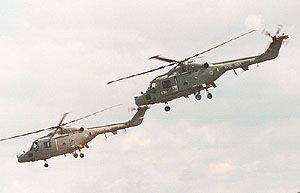 the airshow would have already seen
these particular aircraft out in the open on a number of occasions. However, it was
particularly welcome to see Meteor NF14 WS843 out of hibernation
and released from storage for display outside the VIP tent near the flightline. the airshow would have already seen
these particular aircraft out in the open on a number of occasions. However, it was
particularly welcome to see Meteor NF14 WS843 out of hibernation
and released from storage for display outside the VIP tent near the flightline.
The third element of the static, the SoTT airframes, again proved to be the main area of disappointment,
thanks to the seemingly continued reluctance to treat their display as anything other than
an afterthought. In a virtual re-run of last years show, out of a grand total of twelve Jet Provosts, only one was accessible for photography, thanks to a
combination of cockpit covers and extremely tight parking. (It’s quite possible that
a new record has now been set for how many JPs can be fitted within the equivalent of a
squash court!).
The ground instructional Jaguars fared a little better
than last year, with a larger selection on display, but there was still room for
improvement regarding aircraft layout and proximity of barriers. There was also the usual
hangar display of Jaguars, with the customary undercarriage retraction demo, along with
selected cockpits opened up for all the budding young pilots in attendance. One of the
Jags outside, XX110/EP, was still painted in the Gulf War scheme
it acquired at Cosford some time ago. Having been ground instructional since about 1989,
it is not a genuine Gulf veteran, but it certainly made you think; "Is it really over
ten years since I saw the first Desert Pink Jaguar? - Gulp! Where’s the time
gone?"
 The flying display itself was scheduled to start,
as always, around 13:00 and lasted the best part of four and a half hours. The show was
opened appropriately by a Tutor, to demonstrate what the resident Birmingham UAS will be
flying for the foreseeable future. This was followed by a graceful glider demonstration,
before the unmistakable drone of a C-130 signalled the start of the Falcons parachute
display. The clouds had really rolled in by this time, so they were forced to jump from
3,000ft, rather than the usual 12,000ft. Despite the brisk crosswind, all the guys kept a
tight formation stack all the way down to the their target LZ, where they all landed
within feet of each other. Then, suitably unclipped from their chutes, they took the
salute, and the deserved applause from the audience, as the Hercules performed the
customary fly-by. The flying display itself was scheduled to start,
as always, around 13:00 and lasted the best part of four and a half hours. The show was
opened appropriately by a Tutor, to demonstrate what the resident Birmingham UAS will be
flying for the foreseeable future. This was followed by a graceful glider demonstration,
before the unmistakable drone of a C-130 signalled the start of the Falcons parachute
display. The clouds had really rolled in by this time, so they were forced to jump from
3,000ft, rather than the usual 12,000ft. Despite the brisk crosswind, all the guys kept a
tight formation stack all the way down to the their target LZ, where they all landed
within feet of each other. Then, suitably unclipped from their chutes, they took the
salute, and the deserved applause from the audience, as the Hercules performed the
customary fly-by.
Once the Herc had landed, it was time for the crowds to
witness their first fast jet of the afternoon. This subsequently saw a polished display
from a 208(R) Squadron Hawk T1. Naturally the event was well supported by the RAF, and as
the afternoon wore on, there were subsequent flying demonstrations from a 1 FTS Tucano T1,
16(R) Squadron Jaguar GR3, 56(R) Squadron Tornado F3, 20(R) Squadron Harrier GR7, and
42(R) Squadron Nimrod MR2, as well as expected participation from the BBMF. This entailed
a double display slot, which firstly comprised the classic trio of Lancaster, Spitfire,
and Hurricane, followed a little later by a solo display from the Dakota.
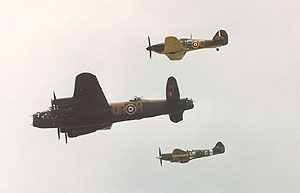 Prior to the BBMF, there had also been the usual participation from the RNHF.
This not only entailed the customary flying of the flag by the impossibly slow Swordfish,
but also saw the welcome return of a RN operated Sea Fury over Cosford. The RNHF had been
without an example of Hawker’s classic fighter since the unfortunate forced landing
of their T20 WG655 way back in July 1990. However, thanks to much assistance from BAE
Systems over the last few years, FB11 VR930 has been restored to airworthiness, and made
its first post-restoration flight from Yeovilton in March this year. It was great to hear
the distinctive sound of a growling Bristol Centaurus again. Prior to the BBMF, there had also been the usual participation from the RNHF.
This not only entailed the customary flying of the flag by the impossibly slow Swordfish,
but also saw the welcome return of a RN operated Sea Fury over Cosford. The RNHF had been
without an example of Hawker’s classic fighter since the unfortunate forced landing
of their T20 WG655 way back in July 1990. However, thanks to much assistance from BAE
Systems over the last few years, FB11 VR930 has been restored to airworthiness, and made
its first post-restoration flight from Yeovilton in March this year. It was great to hear
the distinctive sound of a growling Bristol Centaurus again.
The modern day Navy was represented with a display by a
700M Squadron Merlin HM1, as well as a Lynx pair from 702 Squadron. The use of two Lynx
helicopters, rather than the usual singleton, proved to be very popular with the crowds,
thanks to the well choreographed and imaginative demonstration, which included a clever
sequence where one Lynx lands on the runway and then exactly matches the same pirouettes
as his airborne colleague. 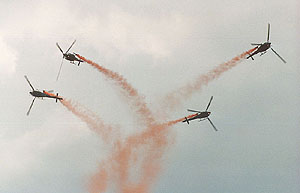 Further rotary winged entertainment
was provided by the AAC Blue Eagles, who proved to be as popular as ever, judging by the
ripples of applause after they had landed. Further rotary winged entertainment
was provided by the AAC Blue Eagles, who proved to be as popular as ever, judging by the
ripples of applause after they had landed.
As far as warbirds were concerned, there was also a
distinctly naval influence to be found amongst the participants. These comprised of a solo
display from the Avenger of Tony Haig-Thomas, along with a quartet of carrier operated big
pistons from The Fighter Collection. This involved two dual displays from firstly the
Corsair and Bearcat, and then the Hellcat and Skyraider.
Classic jets were not forgotten, with two memorable
displays being accomplished during the afternoon. First of all the crowds were treated to
a Hunter duo from the Classic Jet  Aircraft Co, which saw both single and two seat versions flying together in a
series of formation passes, before the two split to perform their individual
demonstrations. Then, later in the afternoon, a brief return of the naval theme saw a
stunning display from De Havilland Aviation’s magnificent Sea Vixen D3 XP924/G-CVIX.
It was virtually impossible not to be awe-struck by the sight and sound of this big twin
boom jet as it powered around the airfield, with the spectacle being further enhanced by
the distinctive red and yellow colour scheme. Apparently, there is the possibility that
the Vixen will be repainted in the traditional RN grey and white colour scheme at some
point in the future. Whilst this would be more representative of the original service life
of XP924, in some respects it would be a shame. Not only does the current colour scheme
give a more dramatic visual impact during its display, but it also reminds everyone of the
unique nature of this particular airframe, the last surviving D3. No doubt, time will
tell. Aircraft Co, which saw both single and two seat versions flying together in a
series of formation passes, before the two split to perform their individual
demonstrations. Then, later in the afternoon, a brief return of the naval theme saw a
stunning display from De Havilland Aviation’s magnificent Sea Vixen D3 XP924/G-CVIX.
It was virtually impossible not to be awe-struck by the sight and sound of this big twin
boom jet as it powered around the airfield, with the spectacle being further enhanced by
the distinctive red and yellow colour scheme. Apparently, there is the possibility that
the Vixen will be repainted in the traditional RN grey and white colour scheme at some
point in the future. Whilst this would be more representative of the original service life
of XP924, in some respects it would be a shame. Not only does the current colour scheme
give a more dramatic visual impact during its display, but it also reminds everyone of the
unique nature of this particular airframe, the last surviving D3. No doubt, time will
tell.
In order to give proceedings an international flavour,
there were also two contributions from overseas, firstly from Belgium, and then France
later in the afternoon. Operating from nearby RAF Shawbury, the crowds were treated to two
very distinctive demonstrations of speed and agility from a Belgian AF F-16A, and then a
French AF Mirage 2000B. With both pilots using copious amounts of re-heat, it was
difficult to say which was the most impressive, but both were well received by the
audience.
 As the afternoon wore on, the previously mentioned cloud cover began to slowly
dissipate. So much so, that when the final solo display item, the Nimrod, performed a last
pass before departure, there was nothing above the airfield but clear blue skies, with the
occasional white fluffy cloud. Thus the stage was set for the Red Arrows to work their
magic, and to enthral their adoring fans one more time. A fitting climax to an afternoon
of airborne entertainment, which proved to be a well-balanced programme of jets and
warbirds. As the afternoon wore on, the previously mentioned cloud cover began to slowly
dissipate. So much so, that when the final solo display item, the Nimrod, performed a last
pass before departure, there was nothing above the airfield but clear blue skies, with the
occasional white fluffy cloud. Thus the stage was set for the Red Arrows to work their
magic, and to enthral their adoring fans one more time. A fitting climax to an afternoon
of airborne entertainment, which proved to be a well-balanced programme of jets and
warbirds.
With a number of ground based attractions
to complement the airshow, such as the Sunday market, craft fair,
fairground, as well as the RAF Museum, there is no doubt that Cosford
remains a firm favourite with countless locals as the ideal family
day out. From the minority view of the enthusiast, if the powers that
be could be persuaded to go that extra mile, and spend a little more
effort on the static display, then this could ultimately lead to a
complete airshow package that would fully satisfy both families and
enthusiasts alike.

|
 Cosy
Cosford
Cosy
Cosford
 The main static park was
effectively dominated by the first time appearance at Cosford of an RAF Merlin HC3,
ZJ125/J from 28 Squadron at Benson. Unfortunately, of all the static aircraft present, it
had to be the Merlin that was blighted by poor barrier positioning, which ensured many
mutterings of discontent from all the photographers taking advantage of the early morning
sunshine. However, a pair of static participants, parked just a short distance from the
Merlin, swiftly tempered this discontent. Making an all-too rare appearance in the UK, was
a pair of Irish Air Corps SF260WE Warriors; 227 &
The main static park was
effectively dominated by the first time appearance at Cosford of an RAF Merlin HC3,
ZJ125/J from 28 Squadron at Benson. Unfortunately, of all the static aircraft present, it
had to be the Merlin that was blighted by poor barrier positioning, which ensured many
mutterings of discontent from all the photographers taking advantage of the early morning
sunshine. However, a pair of static participants, parked just a short distance from the
Merlin, swiftly tempered this discontent. Making an all-too rare appearance in the UK, was
a pair of Irish Air Corps SF260WE Warriors; 227 &  the airshow would have already seen
these particular aircraft out in the open on a number of occasions. However, it was
particularly welcome to see Meteor NF14
the airshow would have already seen
these particular aircraft out in the open on a number of occasions. However, it was
particularly welcome to see Meteor NF14  The flying display itself was scheduled to start,
as always, around 13:00 and lasted the best part of four and a half hours. The show was
opened appropriately by a Tutor, to demonstrate what the resident Birmingham UAS will be
flying for the foreseeable future. This was followed by a graceful glider demonstration,
before the unmistakable drone of a C-130 signalled the start of the Falcons parachute
display. The clouds had really rolled in by this time, so they were forced to jump from
3,000ft, rather than the usual 12,000ft. Despite the brisk crosswind, all the guys kept a
tight formation stack all the way down to the their target LZ, where they all landed
within feet of each other. Then, suitably unclipped from their chutes, they took the
salute, and the deserved applause from the audience, as the Hercules performed the
customary fly-by.
The flying display itself was scheduled to start,
as always, around 13:00 and lasted the best part of four and a half hours. The show was
opened appropriately by a Tutor, to demonstrate what the resident Birmingham UAS will be
flying for the foreseeable future. This was followed by a graceful glider demonstration,
before the unmistakable drone of a C-130 signalled the start of the Falcons parachute
display. The clouds had really rolled in by this time, so they were forced to jump from
3,000ft, rather than the usual 12,000ft. Despite the brisk crosswind, all the guys kept a
tight formation stack all the way down to the their target LZ, where they all landed
within feet of each other. Then, suitably unclipped from their chutes, they took the
salute, and the deserved applause from the audience, as the Hercules performed the
customary fly-by.  Prior to the BBMF, there had also been the usual participation from the RNHF.
This not only entailed the customary flying of the flag by the impossibly slow Swordfish,
but also saw the welcome return of a RN operated Sea Fury over Cosford. The RNHF had been
without an example of Hawker’s classic fighter since the unfortunate forced landing
of their T20 WG655 way back in July 1990. However, thanks to much assistance from BAE
Systems over the last few years, FB11 VR930 has been restored to airworthiness, and made
its first post-restoration flight from Yeovilton in March this year. It was great to hear
the distinctive sound of a growling Bristol Centaurus again.
Prior to the BBMF, there had also been the usual participation from the RNHF.
This not only entailed the customary flying of the flag by the impossibly slow Swordfish,
but also saw the welcome return of a RN operated Sea Fury over Cosford. The RNHF had been
without an example of Hawker’s classic fighter since the unfortunate forced landing
of their T20 WG655 way back in July 1990. However, thanks to much assistance from BAE
Systems over the last few years, FB11 VR930 has been restored to airworthiness, and made
its first post-restoration flight from Yeovilton in March this year. It was great to hear
the distinctive sound of a growling Bristol Centaurus again. Further rotary winged entertainment
was provided by the AAC Blue Eagles, who proved to be as popular as ever, judging by the
ripples of applause after they had landed.
Further rotary winged entertainment
was provided by the AAC Blue Eagles, who proved to be as popular as ever, judging by the
ripples of applause after they had landed. Aircraft Co, which saw both single and two seat versions flying together in a
series of formation passes, before the two split to perform their individual
demonstrations. Then, later in the afternoon, a brief return of the naval theme saw a
stunning display from De Havilland Aviation’s magnificent Sea Vixen D3 XP924/G-CVIX.
It was virtually impossible not to be awe-struck by the sight and sound of this big twin
boom jet as it powered around the airfield, with the spectacle being further enhanced by
the distinctive red and yellow colour scheme. Apparently, there is the possibility that
the Vixen will be repainted in the traditional RN grey and white colour scheme at some
point in the future. Whilst this would be more representative of the original service life
of XP924, in some respects it would be a shame. Not only does the current colour scheme
give a more dramatic visual impact during its display, but it also reminds everyone of the
unique nature of this particular airframe, the last surviving D3. No doubt, time will
tell.
Aircraft Co, which saw both single and two seat versions flying together in a
series of formation passes, before the two split to perform their individual
demonstrations. Then, later in the afternoon, a brief return of the naval theme saw a
stunning display from De Havilland Aviation’s magnificent Sea Vixen D3 XP924/G-CVIX.
It was virtually impossible not to be awe-struck by the sight and sound of this big twin
boom jet as it powered around the airfield, with the spectacle being further enhanced by
the distinctive red and yellow colour scheme. Apparently, there is the possibility that
the Vixen will be repainted in the traditional RN grey and white colour scheme at some
point in the future. Whilst this would be more representative of the original service life
of XP924, in some respects it would be a shame. Not only does the current colour scheme
give a more dramatic visual impact during its display, but it also reminds everyone of the
unique nature of this particular airframe, the last surviving D3. No doubt, time will
tell. As the afternoon wore on, the previously mentioned cloud cover began to slowly
dissipate. So much so, that when the final solo display item, the Nimrod, performed a last
pass before departure, there was nothing above the airfield but clear blue skies, with the
occasional white fluffy cloud. Thus the stage was set for the Red Arrows to work their
magic, and to enthral their adoring fans one more time. A fitting climax to an afternoon
of airborne entertainment, which proved to be a well-balanced programme of jets and
warbirds.
As the afternoon wore on, the previously mentioned cloud cover began to slowly
dissipate. So much so, that when the final solo display item, the Nimrod, performed a last
pass before departure, there was nothing above the airfield but clear blue skies, with the
occasional white fluffy cloud. Thus the stage was set for the Red Arrows to work their
magic, and to enthral their adoring fans one more time. A fitting climax to an afternoon
of airborne entertainment, which proved to be a well-balanced programme of jets and
warbirds.